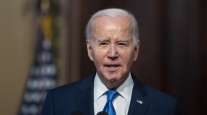US Hails Progress in China Talks Amid Push to Close the Deal

President Donald Trump’s top economic adviser touted progress in high-level talks with China, but cautioned that a final deal to end the trade war remains elusive as negotiations resumed in Washington.
Negotiators are “making good headway,” White House economic adviser Larry Kudlow told reporters April 3 in Washington. “But we’re not there and we hope this week to get closer,” he said. U.S. stocks rebounded following his remarks.
The comments came as negotiations shifted to the U.S. capital following a week of discussions in Beijing. U.S. Trade Representative Robert Lighthizer greeted Chinese Vice Premier Liu He as he entered the USTR offices in Washington on April 3 for the latest round of talks.
The main outstanding issues include protection for American intellectual property and an enforcement mechanism to ensure China honors its commitments in a trade agreement.
China touted “new progress” after last week’s talks and both sides have been working line-by-line through the text of an agreement that can be put before Trump and his Chinese counterpart Xi Jinping, according to people familiar with the matter. China has already announced various concessions and pledged to open up industries in steps.
U.S. stocks rose April 3 amid expectations that a deal could soon materialize. Any hint that the talks have run into deadlock will unnerve investors and trigger fresh concerns for the world economy, which has already been rattled by tit-for-tat tariffs that the U.S. and China have imposed on each others goods.
Both countries have yet to agree on what happens to existing U.S. duties on Chinese goods and the terms of an enforcement mechanism to ensure China keeps to the trade deal, the Financial Times reported, citing people briefed on the talks. Other than that, U.S. and China officials have resolved most of the issues surrounding the deal, the FT reported.
Negotiations so far have focused mainly on what China will do to reduce its goods trade surplus with the U.S., which reached a record $419.2 billion last year. Beijing has made some big offers in this area, such as a pledge to reduce the deficit to zero by 2024 — close to the end of a potential Trump second term.
That would involve a dramatic, and some say impossible, ramping up of purchases of agricultural goods, commodities, aircraft and other items. Nevertheless, China has already made moves in this area, including with plans to import record amounts of U.S. pork and re-entering the market for U.S. soybeans. Boeing Co.’s role in this equation has now been complicated by China’s grounding of its 737 Max jet.
A major sticking point has been a U.S. demand that it retain the power to police the application of the deal. The U.S. wants regular meetings to assess whether China is living up to promises, and wants to be able to impose tariffs on China— with no threat of counter-retaliation — if it fails to do so, Kudlow has said.
That has left negotiators diametrically opposed: China wants all tariffs that have been imposed in the course of the past 12 months removed, while the U.S. wants to retain some as part of its enforcement mechanism. Trump advisers say China has failed to meet commitments in the past, one reason they decided early in the president’s term to emphasize the stick over the carrot.




